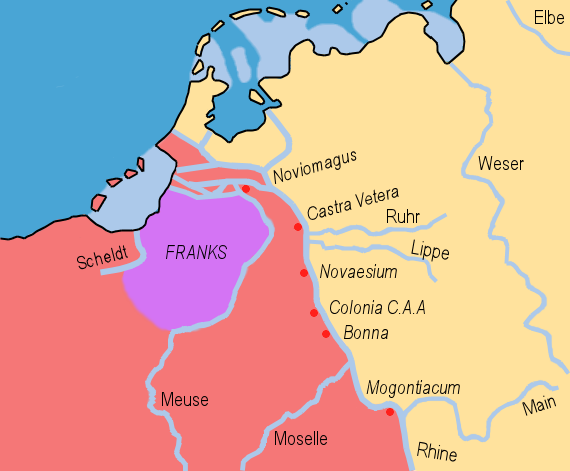|
Solms-Wildenfels
Solms-Wildenfels was a minor County around Wildenfels in south-western Saxony, Germany. The House of Solms had its origins at Solms, Hesse. Solms-Wildenfels was a partition of Solms-Baruth. In 1741 it was partitioned between itself and Solms-Sachsenfeld, and reintegrated that County upon its extinction in 1896. Solms-Wildenfels was mediatised to Hesse-Darmstadt in 1806. Counts of Solms-Wildenfels (1696–1806) * Otto Henry William (1696–1741) * Henry Charles (1741–46) * Frederick Magnus I (1746–1801) * Frederick Magnus II (1801–06) Mediatized Counts of Solms-Wildenfels * Friedrich Magnus II (1806–1857) * Friedrich Magnus III (1857-1883) * Friedrich Magnus IV (1883-1910) * Friedrich Magnus V (1910-1945), married Princess Marie Antoinette of Schwarzburg, who presumably became the head of the House of Schwarzburg in 1971. Following her brother's death in 1971 in the House of Schwarzburg became extinct in the male line. However the Schwarzburg principalities oper ... [...More Info...] [...Related Items...] OR: [Wikipedia] [Google] [Baidu] |
Friedrich Magnus, Count Of Solms-Wildenfels
Friedrich Magnus VI, Count of Solms-Wildenfels (born 18 January 1927) is the head of the House of Solms-Wildenfels. Under Semi-Salic primogeniture, he could have a claim to the headship of the House of Schwarzburg through his mother, as heir to the principalities of Schwarzburg-Rudolstadt and Schwarzburg-Sondershausen,James, John ''Almanach de Gotha, Volume I'', 2013. as well as a claim to the extinct House of Godwin, as he is a descendant of Harold Godwinson, the last Anglo-Saxon king of England, through his second daughter. Early life He was born in Wildenfels in Saxony, the son of Friedrich Magnus V, Count of Solms-Wildenfels (1886–1945) and his wife Princess Marie Antoinette of Schwarzburg (1898–1984). Marriage Count Friedrich Magnus married first on 7 February 1948 at Esslingen am Neckar in Baden-Württemberg, to Katharina Duerst (1923-1970), daughter of Harald Eduard Duerst and Käthe Saile. The couple were divorced in 1954 and remarried in 1966. Count Friedrich Ma ... [...More Info...] [...Related Items...] OR: [Wikipedia] [Google] [Baidu] |
Princess Marie Antoinette Of Schwarzburg
Marie Antoinette, Princess of Schwarzburg (german: Marie Antoinette Prinzessin zu Schwarzburg; 7 February 18984 November 1984) was the eldest child of Sizzo, Prince of Schwarzburg. Early life and background Marie Antoinette was born at Großharthau, Kingdom of Saxony, the first child of Sizzo, Prince of Schwarzburg (1860–1926), and his wife, Princess Alexandra of Anhalt (1868–1958). Her father was the son of Friedrich Günther, Prince of Schwarzburg-Rudolstadt, and Countess Helena von Reina (1835-1860); and her mother was the daughter of Frederick I, Duke of Anhalt, and Princess Antoinette of Saxe-Altenburg. Through her mother she was descendant of King Frederick William II of Prussia. Marriage Marie Antoinette married on 4 January 1925 in Wildenfels to Friedrich Magnus V, Count of Solms-Wildenfels (1886–1945), only son of Friedrich Magnus IV, Count of Solms-Wildenfels (1847-1910) and his wife, Anna Jacqueline, Countess of Bentinck-Aldenburg-Middachten (1855-1903). ... [...More Info...] [...Related Items...] OR: [Wikipedia] [Google] [Baidu] |
Solms-Wildenfels Solms-Baruth (Counts) Coat Of Arms
Solms-Wildenfels was a minor County around Wildenfels in south-western Saxony, Germany. The House of Solms had its origins at Solms, Hesse. Solms-Wildenfels was a partition of Solms-Baruth. In 1741 it was partitioned between itself and Solms-Sachsenfeld, and reintegrated that County upon its extinction in 1896. Solms-Wildenfels was mediatised to Hesse-Darmstadt in 1806. Counts of Solms-Wildenfels (1696–1806) * Otto Henry William (1696–1741) * Henry Charles (1741–46) * Frederick Magnus I (1746–1801) * Frederick Magnus II (1801–06) Mediatized Counts of Solms-Wildenfels * Friedrich Magnus II (1806–1857) * Friedrich Magnus III (1857-1883) * Friedrich Magnus IV (1883-1910) * Friedrich Magnus V (1910-1945), married Princess Marie Antoinette of Schwarzburg, who presumably became the head of the House of Schwarzburg in 1971. Following her brother's death in 1971 in the House of Schwarzburg became extinct in the male line. However the Schwarzburg principalities oper ... [...More Info...] [...Related Items...] OR: [Wikipedia] [Google] [Baidu] |
Friedrich Günther, Prince Of Schwarzburg
Friedrich Günther, Prince of Schwarzburg (5 March 1901 – 9 November 1971) was the final head of the House of Schwarzburg and heir to the formerly sovereign principalities of Schwarzburg-Rudolstadt and Schwarzburg-Sondershausen. Early life He was born in Großharthau in the Kingdom of Saxony the son of Prince Sizzo von Leutenberg (1860–1926) and his wife, Princess Alexandra of Anhalt (1868–1958). On 21 April 1896, his father had been recognised as a dynast of the house as Prince Sizzo of Schwarzburg, having previously lacked succession rights due to his parents' morganatic marriage. In 1909 the two Schwarzburg principalities were united in a personal union under Prince Günther of Schwarzburg-Rudolstadt. This followed the extinction of the elder Sondershausen branch, at which point Friedrich Günther became second in line to the united principality, following Sizzo. But the German Revolution prompted Prince Günther to abdicate on 22 November 1918, thereby ending the ... [...More Info...] [...Related Items...] OR: [Wikipedia] [Google] [Baidu] |
German Mediatisation
German mediatisation (; german: deutsche Mediatisierung) was the major territorial restructuring that took place between 1802 and 1814 in Germany and the surrounding region by means of the mass mediatisation and secularisation of a large number of Imperial Estates. Most ecclesiastical principalities, free imperial cities, secular principalities, and other minor self-ruling entities of the Holy Roman Empire lost their independent status and were absorbed into the remaining states. By the end of the mediatisation process, the number of German states had been reduced from almost 300 to just 39. In the strict sense of the word, mediatisation consists in the subsumption of an immediate () state into another state, thus becoming ''mediate'' (), while generally leaving the dispossessed ruler with his private estates and a number of privileges and feudal rights, such as low justice. For convenience, historians use the term ''mediatisation'' for the entire restructuring process that t ... [...More Info...] [...Related Items...] OR: [Wikipedia] [Google] [Baidu] |
Wildenfels
Wildenfels is a municipality in Germany, Landkreis Zwickau in Saxony. It is situated 9 km southeast of Zwickau. The construction of Wildenfels castle was begun before 1200 by the lords of Wildenfels. Between 1440 and 1706 it was a fief with Imperial immediacy. In 1602 it passed to the House of Solms which established the branch of Solms-Wildenfels Solms-Wildenfels was a minor County around Wildenfels in south-western Saxony, Germany. The House of Solms had its origins at Solms, Hesse. Solms-Wildenfels was a partition of Solms-Baruth. In 1741 it was partitioned between itself and Solms- .... The counts of Solms-Wildenfels resided there until communist expropriation in 1945. Presently the castle is used for weddings and other events, partially for housing, the courtyards are accessible. References Zwickau (district) {{Zwickau-geo-stub ... [...More Info...] [...Related Items...] OR: [Wikipedia] [Google] [Baidu] |
Solms
Geography Location Solms lies right in the Lahn valley at the mouth of the eponymous little river Solmsbach and is nestled between the foothills of both the Taunus and Westerwald at heights from 140 to 400 m above sea level. It is about 7 km west of Wetzlar and 30 km northeast of Limburg an der Lahn. Neighbouring communities Solms borders in the north on the community of Ehringshausen and the town of Aßlar, in the east on the town of Wetzlar, in the southeast on the community of Schöffengrund, in the southwest on the town of Braunfels and in the west on the town of Leun (all in the Lahn-Dill-Kreis). Constituent communities The town consists of the following centres: *Albshausen * Burgsolms * Niederbiel * Oberbiel * Oberndorf Solms is a town west of Wetzlar in the Lahn-Dill-Kreis, Hessen, Germany with around 13,500 inhabitants. In the constituent community of Burgsolms once stood the ancestral castle of the Counts and Princes of Solms. Politics Town counc ... [...More Info...] [...Related Items...] OR: [Wikipedia] [Google] [Baidu] |
House Of Schwarzburg
The House of Schwarzburg was one of the oldest noble families of Thuringia. Upon the death of Prince Friedrich Günther in 1971, a claim to the headship of the house passed under Semi-Salic primogeniture to his elder sister, Princess Marie Antoinette of Schwarzburg who married Friedrich Magnus V, Count of Solms-Wildenfels.James, John ''Almanach de Gotha, Volume I'', 2013. Reigning over the County of Schwarzburg and founded by Sizzo I of Schwarzburg (died 1160), the family split in the 16th century into the lines of Schwarzburg-Sondershausen and Schwarzburg-Rudolstadt, with the Sondershausen dying out in 1909. Family history The County of Schwarzburg was a state of the Holy Roman Empire from 1195 to 1595, when it was partitioned into Schwarzburg-Rudolstadt and Schwarzburg-Sondershausen. It was ruled by counts from the House of Schwarzburg. Schwarzburg Castle was first mentioned in a 1071 deed. In 1123 Count Sizzo III of Käfernburg (Kevernburg), mentioned by the medieval chron ... [...More Info...] [...Related Items...] OR: [Wikipedia] [Google] [Baidu] |
Semi-Salic Law
The Salic law ( or ; la, Lex salica), also called the was the ancient Frankish civil law code compiled around AD 500 by the first Frankish King, Clovis. The written text is in Latin and contains some of the earliest known instances of Old Dutch. It remained the basis of Frankish law throughout the early Medieval period, and influenced future European legal systems. The best-known tenet of the old law is the principle of exclusion of women from inheritance of thrones, fiefs, and other property. The Salic laws were arbitrated by a committee appointed and empowered by the King of the Franks. Dozens of manuscripts dating from the sixth to eighth centuries and three emendations as late as the ninth century have survived. Salic law provided written codification of both civil law, such as the statutes governing inheritance, and criminal law, such as the punishment for murder. Although it was originally intended as the law of the Franks, it has had a formative influence on the ... [...More Info...] [...Related Items...] OR: [Wikipedia] [Google] [Baidu] |
Salic Law
The Salic law ( or ; la, Lex salica), also called the was the ancient Frankish civil law code compiled around AD 500 by the first Frankish King, Clovis. The written text is in Latin and contains some of the earliest known instances of Old Dutch. It remained the basis of Frankish law throughout the early Medieval period, and influenced future European legal systems. The best-known tenet of the old law is the principle of exclusion of women from inheritance of thrones, fiefs, and other property. The Salic laws were arbitrated by a committee appointed and empowered by the King of the Franks. Dozens of manuscripts dating from the sixth to eighth centuries and three emendations as late as the ninth century have survived. Salic law provided written codification of both civil law, such as the statutes governing inheritance, and criminal law, such as the punishment for murder. Although it was originally intended as the law of the Franks, it has had a formative influence on the trad ... [...More Info...] [...Related Items...] OR: [Wikipedia] [Google] [Baidu] |
Solms-Baruth
Solms-Baruth was a Lower Lusatian state country, from 16th century until 1945. History The House of Solms had its origins at Solms, Hesse, and ruled several of the many minor states of the Holy Roman Empire. These lost their independence in the German Mediatization of 1806. Later the Baruth branch also purchased the estates of Golßen and Casel in the March of Lusatia and, in 1767, Kliczków Castle (Klitschdorf) in Silesia which became their main seat. They owned Baruth and the other estates from 1615 to 1945 (when they were expropriated in communist East Germany), including the manor houses, ten villages and about 15,000 hectares of agriculture and forestry land. In 1635, the March passed from the Kingdom of Bohemia to the Electorate of Saxony which in 1806 became the Kingdom of Saxony, with the counts of Solms-Baruth occupying a hereditary seat in the Saxonian Landtag. In 1815, when Saxony was punished at the Congress of Vienna for its loyalty to Napoleon by the confiscation o ... [...More Info...] [...Related Items...] OR: [Wikipedia] [Google] [Baidu] |








